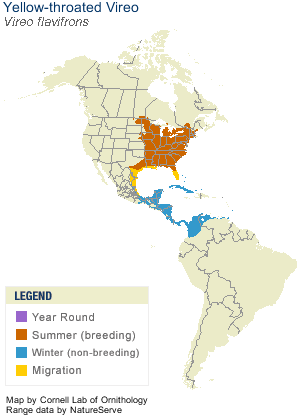|
|
|
 |
Yellow-throated Vireo
|
| Accipiter cooperii | |
A bird of open deciduous forests, the Yellow-throated Vireo is the most colorful member of its family in North America.
Interesting Information
-
While the Yellow-throated Vireo is associated with forest edge habitat, it actually requires large blocks of forest to breed successfully. Numbers decrease sharply in forests smaller than 100 hectares (250 acres) in the northeastern United States.
-
The Yellow-throated Vireo is typically a solitary bird on migration and during the winter. It forms only loose associations with mixed-species foraging flocks. In the summer, pairs associate only long enough to raise a brood of young.
-
A group of vireos are collectively known as a "call" of vireos.
-
It requires large blocks of forest to breed successfully. Numbers decrease sharply in forests smaller than 250 acres in the northeastern United States.
-
The Yellow-throated Vireo was first described in 1808 by Louis Jean Pierre Vieillot, a French ornithologist.
-
Their numbers have decreased in recent years because of the spraying of trees with toxic chemicals.
Description
Adult Description
-
Length Range: 13-15 cm (5-6 in)
-
Weight: 17 g (0.6 oz)
Small songbird.
Olive green upperparts.
Bright yellow throat, breast, and eye spectacles.
Belly and under tail white.
Two white wingbars.
Sex Differences
Sexes Similar
Immature
Similar to adult, but paler yellow below and more brownish above.

Photo taken from: The Sibley Field Guide by David Allen Sibley

© 2003 Cornell Lab of Ornithology
|
Habitat |
|
Breeds in a variety of edge habitats in mature deciduous and mixed deciduous forests. |
|
Behavior |
|
Forages in middle and uppers stories of forest, gleaning insects off trunks, branches and leaves. Moves slowly from place to place and searches for a relatively long time from one spot. |
|
Food |
|
Arthropods, some fruits and seeds. |
Taxonomy
| Kingdom: | Animalia |
| Phylum: | Chordata |
| Subphylum: | Vertebrata |
| Class: | Aves |
| Order: | Passeriformes |
| Family: | Vireonidae |
| Genus: | Vireo |
| Species: | Vireo flavifrons |
Similar Species |
|
|
Bird Sound |
|
Song a broken series of burry two- and three-syllable phrases. |
|
Eggs look like this |
|
Photo taken from: ARCTOS Collaborative Collection Management Solution |






